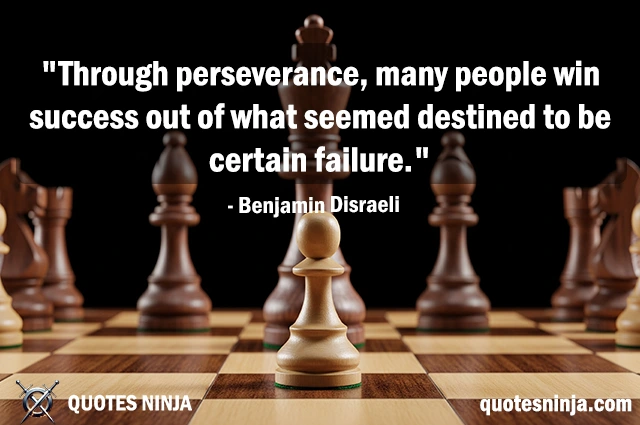
Perseverance Quote: “Through perseverance, many people win success out of what seemed destined to be certain failure.” attributed to Benjamin Disraeli (1804–1881) was a prominent British statesman, novelist, and political thinker, best known for serving twice as the Prime Minister of the United Kingdom (in 1868 and again from 1874 to 1880). He was a leading figure in the Conservative Party and played a key role in shaping modern British conservatism.
Deeper Meaning of Perseverance Quote
This quote highlights the transformative power of perseverance—the ability to keep going despite difficulty, failure, or discouragement.
It suggests that:
- Many people appear to be headed for certain failure—whether due to setbacks, lack of talent, poor circumstances, or overwhelming odds.
- However, those who refuse to give up often end up achieving success, even when it seems unlikely or impossible.
- The key difference isn’t always skill or luck, but persistence—the decision to keep trying, learning, and growing despite challenges.
Here’s a story inspired by Perseverance Quote “Through perseverance, many people win success out of what seemed destined to be certain failure.”
Success Story: “The Quiet Flame“
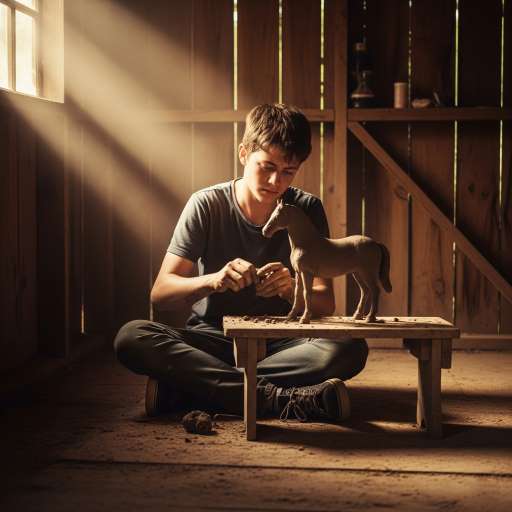
Aarav in His Crumbling Shed at Sunrise:
The sun had just begun to rise over the sleepy village of Nandipur, brushing the sky with hues of orange and gold. At the edge of the village, in a crumbling shed filled with the scent of damp earth and dried leaves, fifteen-year-old Aarav sat hunched over a half-formed horse made of clay.
His hands were cracked, his fingernails packed with mud, and his brow furrowed in concentration. For the fifth time that week, the leg of the clay horse collapsed under its own weight.
He exhaled sharply. “Again,” he muttered to himself.
For generations, Aarav’s family had crafted clay toys and idols for village fairs. But times had changed. Plastic toys from the cities flooded the markets, and the traditional craft lost its charm. His father abandoned the kiln years ago and took up work as a mason. Yet Aarav, driven by stories his grandmother once told him about their great-grandfather’s legendary clay artistry, refused to let the craft die.
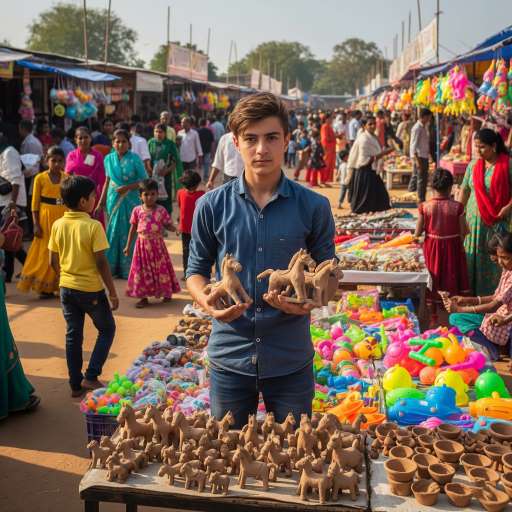
Village Fair Scene with Disinterested Crowd:
Unfortunately, no one else believed in him.
He had tried many times to sell his clay horses at the town fair. But each time, children ignored them, and shopkeepers scoffed at their imperfections. His pieces cracked too easily, the proportions were off, and he lacked the polish of a seasoned artisan.
Still, he returned to the shed every morning.
One morning, as he fetched water from the village well, he overheard a group of men discussing an upcoming regional art competition in the nearby city of Banaras.
“The winner gets ten thousand rupees,” one said. “And a scholarship to study art.”
Aarav’s heart raced. This was more than money — it was recognition. A chance to prove his craft mattered.
That same evening, he told his parents.
His mother looked up from peeling vegetables. “Banaras? That’s two hours away. What will you take to show?”
“My best clay horse,” he replied firmly.
His father sighed. “Beta, this is not a child’s game. Those competitions are for trained artists. Let it go.”
But he didn’t. That very night, under the flickering light of a single kerosene lamp, Aarav returned to his workbench.
Weeks passed. He tried new techniques: soaking the clay longer, refining the armature, mixing husk for strength. But nothing worked.
Each time, the sculpture collapsed, cracked in the kiln, or looked lopsided.
The deadline loomed closer. His fingers blistered. His sleep faded. But he refused to stop.
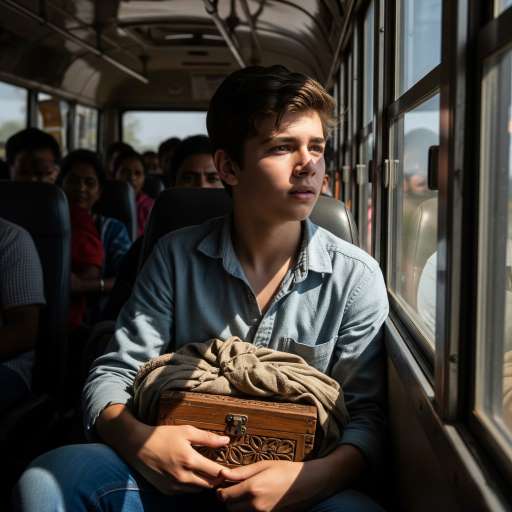
The Bus Ride to Banaras:
When the final day arrived, he had only one horse that survived the kiln—just one. It wasn’t perfect. The left hind leg curved slightly inward, and a faint hairline crack ran beneath its belly. But its form was graceful, and the expression in its eyes felt alive.
Wrapping it carefully in soft cloth, he boarded the early morning bus to Banaras, clutching the box tightly.
The city was larger and louder than Aarav had imagined. He stepped into the grand hall where dozens of artists displayed intricate works—bronze sculptures, glass carvings, paintings bursting with color and technique.
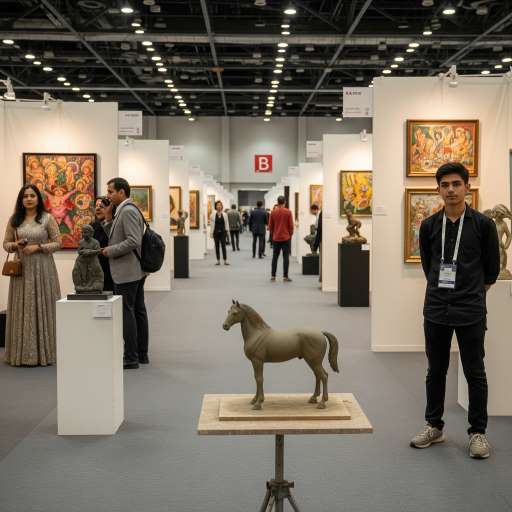
Art Competition Hall with Aarav’s Display:
Aarav’s clay horse, simple and unpolished, sat quietly at the end of the row.
As the judges passed, they nodded politely but showed little interest. One even whispered, “Looks like a school project.”
Aarav felt a knot tighten in his chest. Maybe his father had been right. Maybe he had just wasted weeks chasing a fantasy.
But he didn’t leave.
He stood beside his sculpture until the last moment, answering questions from curious visitors. He told them about Nandipur, about his great-grandfather, about how clay wasn’t just material — it was memory.
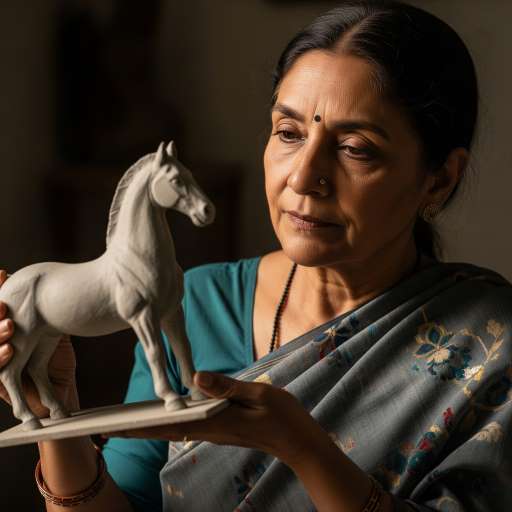
The Woman in Gray Saree Inspecting the Clay Horse:
At the end of the day, a woman in a gray saree approached him. She hadn’t spoken much during the judging rounds, but now she inspected the horse closely.
“It’s not perfect,” she said plainly.
“I know,” Aarav replied, lowering his eyes.
“But it’s honest,” she added. “And it speaks of struggle.”
She turned to him. “You made this?” “Yes, ma’am.”
“And how many times did you try before this one stood?”
“Twenty-three.” She nodded thoughtfully and walked away.

A Letter Through Mail:
Two weeks later, a letter arrived in the mail. Thick paper. Gold-embossed seal. Aarav’s hands trembled as he opened it.
He didn’t win first place. Or second. But he received an honorable mention — and more importantly, an invitation to join a six-month art residency in Banaras, fully funded.
Tears welled in his eyes. He rushed to his father, who stared at the letter for a long time before finally placing a hand on his son’s shoulder.
“I was wrong,” he said softly. “You didn’t win because you were better. You won because you didn’t stop.”
Years later, Aarav would become a respected sculptor known for blending traditional village art with contemporary forms. His pieces were displayed in galleries across India. Yet in every exhibition, he made sure to include a replica of that first horse—the one with the cracked belly and crooked leg.
Here is the ending of Success story from the quote “Through perseverance, many people win success out of what seemed destined to be certain failure.”
Moral of the Story:
You don’t need to be born with extraordinary talent or strength to achieve greatness. True success comes from unwavering focus, consistent discipline, and the desire to master yourself more than the competition. Like Kaito, even an average person can rise above the rest — not by chasing fame or power, but by sharpening their skills every day and staying mentally centered, no matter the pressure.
In short: Focus and persistence turn ordinary people into extraordinary warriors.
To explore more on stories and dive into related ideas, be sure to check out the other posts where we cover all sort of stories related to quotes. Stay tuned for more…..
To explore more on quote topics, be sure to check out the other topics where we cover all categories of quotes. Stay tuned for more…..

